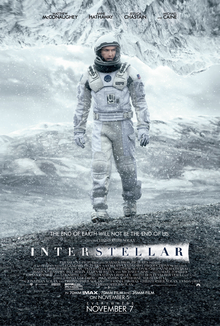
Back Interstellar AN بين النجوم (فيلم) Arabic قائم بين النجوم ARZ Ulduzlararası Azerbaijani اولدوزلار آراسی (فيلم) AZB Інтэрстэлар Byelorussian Інтэрстэлар BE-X-OLD Интерстелар Bulgarian ইন্টারস্টেলার (চলচ্চিত্র) Bengali/Bangla Međuzvjezdani BS
| Interstellar | |
|---|---|
 Theatrical release poster | |
| Directed by | Christopher Nolan |
| Written by |
|
| Produced by |
|
| Starring | |
| Cinematography | Hoyte van Hoytema |
| Edited by | Lee Smith |
| Music by | Hans Zimmer |
Production companies | |
| Distributed by |
|
Release dates |
|
Running time | 169 minutes[1] |
| Countries | |
| Language | English |
| Budget | $165 million[3] |
| Box office | $730.8 million[3] |
Interstellar is a 2014 epic science fiction drama film directed by Christopher Nolan, who co-wrote the screenplay with his brother Jonathan. It stars Matthew McConaughey, Anne Hathaway, Jessica Chastain, Bill Irwin, Ellen Burstyn, Matt Damon, and Michael Caine. Set in a dystopian future where Earth is suffering from catastrophic blight and famine, the film follows a group of astronauts who travel through a wormhole near Saturn in search of a new home for mankind.
The screenplay had its origins in a script Jonathan developed in 2007 and was originally set to be directed by Steven Spielberg. Theoretical physicist Kip Thorne was an executive producer and scientific consultant on the film, and wrote the tie-in book The Science of Interstellar. Cinematographer Hoyte van Hoytema shot it on 35 mm movie film in the Panavision anamorphic format and IMAX 70 mm. Filming began in late 2013 and took place in Alberta, Klaustur, and Los Angeles. Interstellar uses extensive practical and miniature effects, and the company DNEG created additional digital effects.
Interstellar was released in theaters on November 7, 2014. In the United States, it was first released on film stock, expanding to venues using digital projectors. The film received critical acclaim and grossed over $681 million worldwide ($730 million after subsequent re-releases), making it the tenth-highest-grossing film of 2014. Thorne's computer-generated depiction of a black hole in the film has also received commendation from astronomers and physicists.[4][5][6] Interstellar was nominated for five awards at the 87th Academy Awards, winning Best Visual Effects, and received numerous other accolades. This was Lynda Obst's final film as producer before her death in 2024.
- ^ Cite error: The named reference
BBFC-Oct2014was invoked but never defined (see the help page). - ^ a b Cite error: The named reference
LUMIEREwas invoked but never defined (see the help page). - ^ a b Cite error: The named reference
BOMwas invoked but never defined (see the help page). - ^ "10 of the Best Sci-Fi Movies Based on Actual Science". Collider. September 19, 2022. Archived from the original on December 6, 2022. Retrieved December 6, 2022.
- ^ "Interstellar: How it Was One of the Most Scientifically Accurate Sci-Fi Movies Ever". August 31, 2022. Archived from the original on December 6, 2022. Retrieved December 6, 2022.
- ^ Thorne, Kip. "Applied Physics/Physics Colloquium: Kip Thorne – The Physics of the Cult Movie Interstellar". Stanford University. Archived from the original on March 2, 2023. Retrieved March 2, 2023.
Christopher Nolan's cult science fiction film Interstellar (2014) sprang from a treatment co-authored by physicist Kip Thorne, and so had real science — both firm and speculative — embedded in it from the outset.